Nobody associates the Appalachian Trail with the Middle Ages. I wrote that in haste after discovering a faux-medieval monument in a Maryland park. Now I know better—because if you hike north from Gathland for seven miles, the forest opens onto an old highway and the parking lot of an eighteenth-century inn, and across the road you see this:
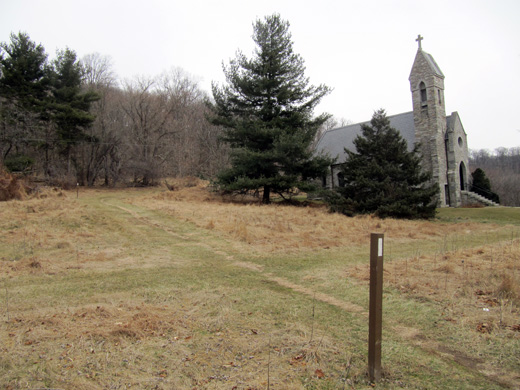
That’s St. Joseph’s Chapel of the Sacred Heart of Jesus, built in the 1880s to serve as a local Catholic mission church and family mausoleum. The Appalachian Trail now runs next to it through the weeds, but this patch of mountain used to be part of the vast summer retreat of Mrs. Madeleine Vinton Dahlgren.
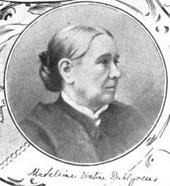 The daughter of a Congressional Whig, Dahlgren was a Washington socialite and much-consulted etiquette expert. She was widowed twice after marrying prominent men: first an Assistant Secretary of the Interior and then later Admiral John Dahlgren, an innovator in naval ordnance. In 1876, the Widow Dahlgren bought an old inn here on South Mountain, fifty miles outside D.C., and made it her summer home. Although the house looked nothing like a castle, she romantically wrote that it seemed to her “like an old manor-seat surrounded by tenantry.” She commissioned this chapel just as the Gothic Revival style was becoming fashionable for churches, prep schools, and universities.
The daughter of a Congressional Whig, Dahlgren was a Washington socialite and much-consulted etiquette expert. She was widowed twice after marrying prominent men: first an Assistant Secretary of the Interior and then later Admiral John Dahlgren, an innovator in naval ordnance. In 1876, the Widow Dahlgren bought an old inn here on South Mountain, fifty miles outside D.C., and made it her summer home. Although the house looked nothing like a castle, she romantically wrote that it seemed to her “like an old manor-seat surrounded by tenantry.” She commissioned this chapel just as the Gothic Revival style was becoming fashionable for churches, prep schools, and universities.
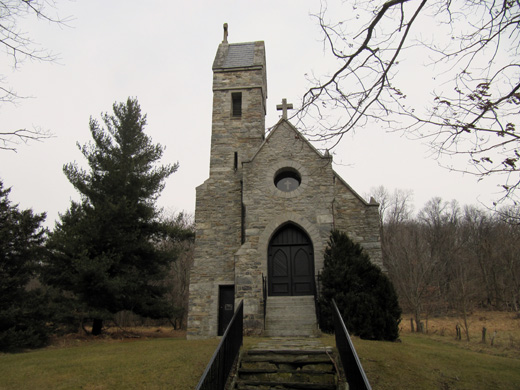
Dahlgren Chapel (as it’s now known) is a solid and serious piece of work, with no gargoyles or grotesques to override dignity with whimsy and few overt nods to modernity. I’m intrigued by the bell tower, which looks like God reached down and gave it a 90-degree turn: Does it imitate any particular medieval church? Is it unusual to find a cross on both the bell tower and the main roof?
I can’t find the name of the architect—hopefully the group working to preserve the chapel will know—but I did learn something interesting from looking into Dahlgren: she was a highly refined writer with more than a passing interest in the Middle Ages.
You wouldn’t detect a yen for the medieval from your first glance at her ouvre: an etiquette guide, novels about Washington society, a bio of her husband and a collection of reminiscences about living in South America during his naval service, a volume of ghost stories—Dahlgren was as prolific as she is forgotten. She deserves better, at least from Maryland readers, because her 1882 book South-Mountain Magic would be smart and engaging even if it weren’t steeped in medieval metaphors and imagery.
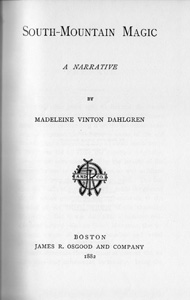 Of mostly local interest, South-Mountain Magic collects Dahlgren’s research into the folkways of her rural neighbors, most of them poor German foresters and mountaineers who weren’t shy about sharing their old-country superstitions. There are stories here about Civil War ghosts on the nearby battlefield, a Native American spirit with its head on fire, jack-o’-lanterns and will-o’-the-wisps, Satanic masses, and even a local wizard whose German spell-book is packed with hexes and cures—which, Dahlgren notes, are always perversions of Christian prayers and rites.
Of mostly local interest, South-Mountain Magic collects Dahlgren’s research into the folkways of her rural neighbors, most of them poor German foresters and mountaineers who weren’t shy about sharing their old-country superstitions. There are stories here about Civil War ghosts on the nearby battlefield, a Native American spirit with its head on fire, jack-o’-lanterns and will-o’-the-wisps, Satanic masses, and even a local wizard whose German spell-book is packed with hexes and cures—which, Dahlgren notes, are always perversions of Christian prayers and rites.
“The prevalence of such a confused mass of superstition as we chronicle, and that too within fifty miles of the very capitol of this vast nation . . . does not prove much as regards a theory of progressive civilization, and the wonderful and special enlightenment of the nineteenth century,” Dahlgren writes with dainty wit. However, her book isn’t a denunciation of occultism and superstition; rather, it’s a careful Catholic argument for studying the supernatural.
Although wary of imitating centuries of “innumerable philosophers and sages, ever seeking for that cabalistic lore, which may overstep the boundary line between the known and the unknown, the seen and the unseen,” Dahlgren waxes theological: What of the “ecstacies, visions, and mystic revelations” of saints who have been allowed glimpses of Heaven? Might not lesser souls with “lower perceptive powers also seize some flashes of light, sent forth from that Divine emanation that permeates creation?” Don’t poets, artists, and musicians have a gift for apprehending the divine? Dahlgren then proposes a scientific justification: By studying magic, we can better understand the relationship between the material and the immaterial, between actions and causes, just as the study of magnetism and electricity has been productive and informative. For all we know, Dahlgren argues, scientific explanations for ghosts and spells may yet be forthcoming.
Today’s Catholic philosophers will still find Dahlgren an articulate, thoughtful ally, but I’m most interested in her respect for the Middle Ages, which suffuses her view of the world. Even as she catalogs local superstitions, she makes a trenchant point about the present: we’re not as “modern” as we think, and an honest comparison with the past should leave us humble but enlightened, like a desert saint:
There is no study, probably, more useful to give the mind something like a just balance, than the comparison of the various forms of civilization, ancient and modern. And yet when such comparisons are made, as they often are, from a sophistical standpoint, they do more harm than good. The class of minds that stultify this present era, without looking carefully through the long vista of the past ages, very much resemble those people who, staying closely at home, make their own contracted notions the standard of excellence.
The present age passes by St. Simon of Stylites poised on his pillar, and jibes at him as an undoubted madman, quite unconscious all the while that he has gained a wider range of vision from his serene height of contemplation, than the dust-stained pilgrims who revile him as they plod onward in the highway below.
To Dahlgren, modern superstitions are the misguided impulses of a soul seeking true religion but settling on “the lovely legends clinging on to the ardent faith of the so-called ‘dark ages,’ although not received as of faith”:
These accepted legends and traditions, orally handed down from generation to generation, frame in the life of the lowly peasant who believes in them, with the absolute beauty of the brilliantly illuminated border of the quaint manuscripts of that age. These borders enclosed, perhaps, a black lettering, but they expressed the true.
As we write, a vision of another and a better world comes before us. We behold the majestic, solemn repose of the monastery, and standing in a niche, as it were, set apart, a venerable figure, with bared head bowed down over the sacred desk in profound contemplation. For here is the Holy Bible, fondly clasped, with its protecting chain . . .
Such faith was of the past. Now what is of the present?
Medievalism was an important part of nineteenth-century Catholicism, and Dahlgren draws on it to offer one of her era’s most charming Catholic arguments against the pride of modern secularism. Her imagery is particularly appropriate now, given how many hikers tromp past her chapel each spring:
It is a long pilgrimage, to be sure, from the mediaeval ages to the present day, and our sandals are turned into shoes, and our shoes have lost their soles in the toilsome journey. So we are at last here, in the broad light of progress, and we enter a fashionable shop to get others more suited to the advanced ideas around us. We are duly pinched and excruciated, somewhat as we once saw the martyrs tortured, only now there is no motive in our suffering to ennoble it; and finally we are told we have “a fit.” How we sigh for the graceful old sandals, that we wore loosely strapped, without having “a fit,” and not high-stepping, tight-compressing, all-torturing, with thin understanding, iron heels and steel springs, as these. But we are assured that our purchase is of the most improved patent and latest style, and our package is handed us.
As we stretch forth our hands to receive it, what blur or film fills our eyes, once so bright with visions of the glorious past? Can we longer see, or do we dream?—for the shoes handed us are wrapped in the rudely torn leaves of a Bible! “May God forgive the impiety!” we explain. “The Bible,” answers the flippant salesman, “is of no special value; it is spread broadcast in this nineteenth century, not chained to the desk as in the Dark Ages. It is cheaper to us than other waste paper, for it is given away by thousands.”
Today, Dahlgren’s home is an inn again, and the land she called her “sky-farm” has been put to other uses, but her chapel stands as a monument to her medievalism—an open respect for the supernatural as a weirder aspect of God’s creation. “The moods that beset us here,” she concluded, “are not to be measured by conventional standards.”
Medievalism as an alternative to or refuge from modernity has a history as long as modernity itself. In Dahlgren’s lifetime, it would find fresh expression not only among Catholic aesthetes but also through the Arts and Crafts movement, in early chivalry-themed scouting clubs and youth groups, among collectors of folklore, and on the pages of popular novels. What brings hikers here isn’t so different. “Truly, this world is replete in mysteries,” Dahlgren wrote. “The golden thread which connects the ages cannot be destroyed.”
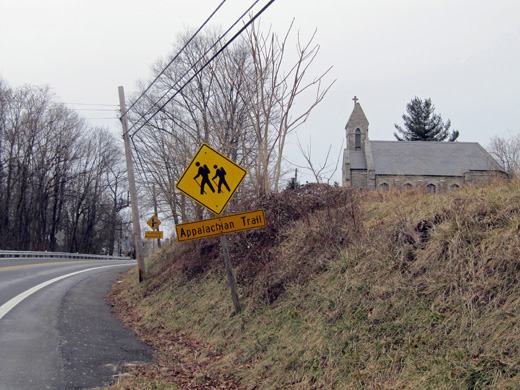

More gothic revival architecture can be found in the neighborhood at the Oxford Movement inspired St. John’s Episcopal Church in Hagerstown.
https://www.360cities.net/image/hagerstown-maryland-st-john-s-episcopal-church-middle-of-the-crossing
LikeLike
Thanks, Gromaticus! I’ve never stopped to look at St. John’s before, but I’ll check it out the next time I pay a visit to the Wonder Book store up there.
The church in Hagerstown that did catch my eye was Trinity Evangelical Lutheran, with its prominent gargoyles. I wrote about it back in 2013:
http://www.quidplura.com/?p=5085
LikeLike
Wonderful post! Interesting woman, interesting foray into the Gothic.
LikeLike
Came back to read it again. Wondering if she had an audience in her own day. And you don’t really say what you thought of “South-Mountain Magic” in terms of how good it is. I’m curious about that also.
I can’t remember if we’ve talked about Henry Chapman Mercer and Fonthill Castle and his Tileworks in Doylestown, but I think of him often in connection with you. Maybe we have?
I’m also thinking you would love to wander around Mons Nubifer Sanctus / St. James Church Lake Delaware (a church built by the Gerry family near Delhi, NY and so sort of in but not in the diocese.) The site is a complex of buildings including cloister walk and now-unused stables designed by Ralph Adams Cram. From the website:
Constructed of Catskill bluestone taken from local fences, and of Indiana limestone, and boasting a slate roof, Saint James Church is a Cram design influenced by the 12th Century Saint Mary’s Church, Iffley, Oxford, England. This transitional period incorporated late Romanesque as well as early Gothic themes as is obvious when one considers the eastern and western windows in Saint James. The interior walls are of white plaster, applied with a mason’s trowel giving it a wavy surface but a smooth texture. The broach roof spire was added to the massive central tower upon the insistence of Miss Angelica Gerry.
LikeLike
Thanks for stopping by again, Marly! South-Mountain Magic is hard to evaluate. Its anecdotes and philosophical digressions don’t quite add up to a coherent book, but I enjoyed it, not only because it shed light on the folklore of this area of Maryland but also because Mrs. Dahlgren writes fine prose. She clearly got a top-notch education, and she’s a much better writer than a certain journalist with literary aspirations, her neighbor seven miles to the south. (That said, her poetry, what I’ve seen of it, isn’t especially memorable, but if there’s a gem there, rest assured I’ll find it.)
It’s not clear to me how big of an audience she had in her day, but it’s a question I might be able to answer in time. I’ve requested a facsimile of one unpublished essay from the archive that holds her papers, and I’m curious to see what else I can learn about her. Honestly, I hadn’t expected to find two quirky, self-made medievalists on a mountain ridge 40 minutes from my home.
Re: Fonthill, I’ve been there and loved it! The Moravian Tileworks, too. The medievalism of Henry Mercer–now there’s a blog post that needs to be written.
And I would definitely enjoy wandering around that family complex built by Cram, who was so steeped in the medieval that he literally wanted us all to go back to living in medieval walled towns! I’d also love to check out a certain ahead-of-its-time Gothic church in Cooperstown. D. and I are overdue for a northward jaunt…
LikeLike